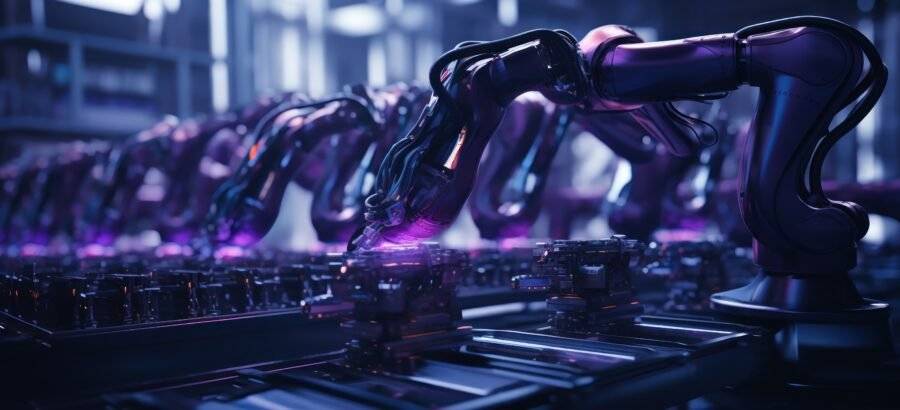*****If you haven’t read our article on Industry 4.0 and Salesforce, check it out here*****
If you haven’t heard of Industry 4.0 by now, then you are probably reading the wrong blogs 😊. But hey, now’s as good a time as ever to find out about it. Now there are digital factories making matters even more exciting in this digital age for manufacturing and supply chain systems.
Digital factories are all about digitizing the manufacturing process (and supply chain systems) by employing the digital technologies that are behind the fourth industrial revolution, also known as Industry 4.0. That means implementing technologies that will disrupt the manufacturing process and supply chain systems for the better to bring efficiency to optimum levels.
The digitization of factories is producing highly customized products through significant efficiency gains and increasingly specified market research. The penultimate goals of digitization can only be realized when companies establish real-time connections to their key suppliers and critical customers.
As manufacturers tune in to the frequency of digital factories, they focus more on the data that feeds the applications they use. The success of it all is measured in how well you turn this data into valuable information by deploying an integrated approach to information management.
As digital factories take center stage, there’s a need to understand what’s driving the digital transformation that’s currently being witnessed in the manufacturing industry.
Factors Driving Digital Transformation In The Manufacturing Industry Of 2019 And Beyond
A survey by the International Data Corporation revealed that even though manufacturers are in a rush to digitally transform, they are struggling to understand the need to shift to a data-driven business. According to the IDC, manufacturers are turning their attention towards leveraging transactional and operational data and combining it with advanced data analytics in a bid to optimize critical business applications.
The IDC survey concludes that for companies to achieve application optimization in this digital transformation era, there’s a need for enterprise views of both unstructured and structured data across the company and beyond. What this means is that there is a need for a data platform for effective data capture, management, and sharing.
As per the survey, the key players driving this digital transformation performed as below:
- ERP was the primary applications (59%)
- Manufacturing Execution Systems (39%)
- Supply Chain Management (38%)
- Product Lifecycle Management (36%)
Basically, this all boils down to the role of Enterprise Information Management (EIM) in enhancing digital transformation in manufacturing.
Digital Factories and Salesforce
It’s undoubtedly that Salesforce is the leading CRM, sales automation, and customer success platform. Salesforce has earned this status by being proactive in innovation and has implemented a series of technologies that are driving the growth of digital factories such as cloud technology, AI, etc.
The fact that information management is becoming the most fundamental game-changer in achieving a competitive advantage in this digital transformation era, any company aiming to shift gear to digitization, must incorporate salesforce into its plans.
Salesforce can capture data that provides an excellent starting point for companies looking to revolutionize how they engage, retain and grow their business reach.
But really, what’s the potential of digital factories in this age of Industry 4.0?
Unlocking The Potential Of Digital Factories
It’s unimaginable. That’s why it’s a hot topic all over manufacturing conferences in Europe and other continents.
#1. Digital factories are influencing most decisions and are high on the top management agenda
According to the survey by IDC, nine out of ten companies (91%) are already investing in digital factories. Another 6% are confident that their companies are already fully digitalized.
To be fully digitalized requires that the said companies invest more and partner with both internal and external stakeholders and install an open innovation approach to the digital transformation. Besides, the same also requires that companies invest more in personnel, train them and get them ready for the digital shift. An excellent example of such a company at this stage is Phillips through its factory in Drachten.
#2. Shifting to a digital factory means customer-centricity and regional manufacturing has to be achieved
About 75% of manufacturers who are busy planning their own digital transformation all have agreed to prioritize regionalization of manufacturing in a bid to improve customer proximity as well as the shift to individualized and flexible production. These, they say, top their main reasons for further investment.
Also, due to the nature of today’s competitive markets, customer-centricity is vital for survival. Serious companies are moving closer to their customers to allow them to enjoy tailor-made products that attract little to no delivery costs.
Through digitization, value chains are now becoming more regionalized, and suppliers are forced to move closer to their customers. All in all, digital factories are providing motivation for companies to up their regionalization efforts to reduce logistics and transportation costs.
#3. Digitization is solidifying the competitiveness of Europe’s industrial center (Germany).
The concept of digital factories is making Germany a real powerhouse for Industry 4.0. Most companies planning their shift to digital factories have chosen Germany to house some if not all of their digital factories. In fact, leading manufacturers have set aside at least 77% of all investments in the next five years for expanding or setting up their digital factories to Germany as well as Western Europe.
The rest of Europe and Asia are only attracting 12% of investments in digital factories with 5% targeting Eastern Europe while another 7% targeting Asia.
#4. Investments in digital factories are strategic, with ROI set to between 2 and 5 years.
Almost half of the manufacturers who are already investing heavily in digital factories expect no quick payback. The ROI they are targeting should happen at least after 2 years and not more than 5 years later. A small group (estimated at 3%) of investors in digital factories expect ROI within the first year.
These periods are proving to be true because as companies gain useful experience with the digitalization of their factories, they get well acquainted with the whole idea of digital factories and can understand their implementation timelines and how effort is needed for success.
#5. Digital Factories prospects up to 12% in efficiency gains for the 5-year ROI timeline
Backed by the power of magical innovations in technology like cloud, automation, and AI, most manufacturers (98%) investing in digital factories give efficiency gains as their main reason for the digital shift. These efficiency gains are realized integrated planning, reduced quality costs, better asset utilization and improved benefits of automation among others.
Also, the levels of efficiency also vary as one moves across different industries with the Engineering (or Industrial equipment) industry being the most optimistic about digital factories’ ability to improve efficiency and revenue by 12% in 5 years.
#6. Digitalization of factories allows factories to be connected both externally and internally through the use of integrated MES (which is extremely a necessary benefit)
If increased efficiency gains are to be achieved, then digitization must allow factories to connect machines and other assets so that there can be cross-communication on a common infrastructure. Furthermore, MES- Manufacturing Execution Systems, must be allowed to plan and control production in real time thus yielding benefits such as enhanced efficiency, better asset utilization, and manufacturing flexibility.
Better yet, integrating these systems with the ERP infrastructure will guarantee the most benefit thus enabling companies to digitize across the entire supply chain as well as internally too.
#7. Digital factories are driving leaner and more productive operations making everything seamless
The digital technologies that underpin the concept of digital factories allow factory workers to achieve more work done faster, improves the quality of products and propels industrial processes faster. This combined with the ability of digital factories to better efficiency and revenue gains, is making the adoption of digital factories by manufacturing rise by promising figures. Technologies such as augmented reality are now allowing factory employees to build zero defect products for the company customers.
#8. Digital Factories allows for smarter decision by companies using predictive data analysis and machine learning
Part of the reasons why Industrial 4.0 is unstoppable is the technology that backs it. Predictive data analysis, Artificial Intelligence, and machine learning all account for the success of digital factories. Companies have already installed these technologies and using smart algorithms to influence critical operational decisions that yield better results.
Companies aiming to beat the competition must join the digital factory wave and be able to connect the dots not only inside the factory but also within the company ecosystem. The other secret powered by digital factories is the intelligent use of information to guide decisions.
#9. The concept of digital factories allows for companies to build a digital work force, a ‘must-have’ for any company looking to realize any degree of competitive advantage
The old has to give way or join the wave of digital factories. It demands the workforce to change, forcing companies to recruit and retrain current employees accordingly. To fully realize the potential of digital factories, companies will hire data scientists able to code smart algorithms capable of improving operational performance. Man-machine interactions in the new digital factories require proper and adequate training and the work-force thereafter can propel the company to digital success.
As the wave of digital factories grow bigger and bigger, one might also ask- how does one get ready for the shift?
Here’s a guideline:
- Defining the needs– identify the critical things in your manufacturing process and start from there.
- Be ready to continually adapt based on demand. Different technologies are being rolled out year in, year out. You must remain flexible to jump ship.
- Take charge of your data handling and connectivity– data is the protagonist of success in this Industry 4.0 era. Manage it successfully, and you are top of the game
- Get ready to upgrade your customer service– use new technologies and industry winners like salesforce to help you understand your customers and implement a strategy to keep them. Think your after-sale service
- Get ready to integrate the factory into the company’s digital ecosystem– The connection between MES systems with the ERP is an excellent improvement point. Horizontal integration should be your goal
In the end…
Digital factories have a huge potential and with the entry of the Industry 4.0, being left behind may not prove to be disastrous, but it’s likely to catch up in the long run. To adapt to the needs of the market and gain competitive advantage, the transformation to digital factories should be a welcome idea in all futuristic companies.
Note: This article consists majorly of facts derived from a PWC report on Digital Factories released in 2017.





